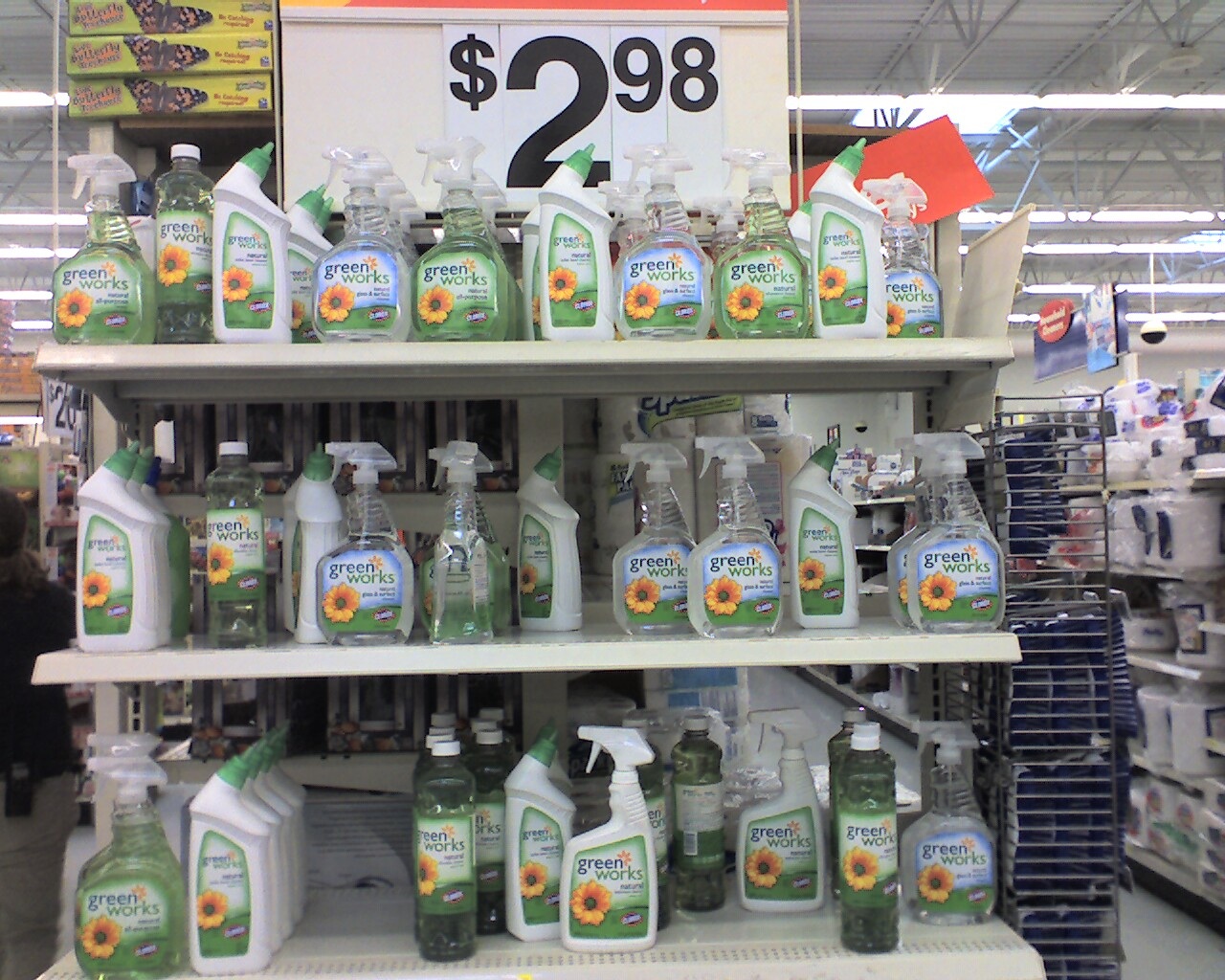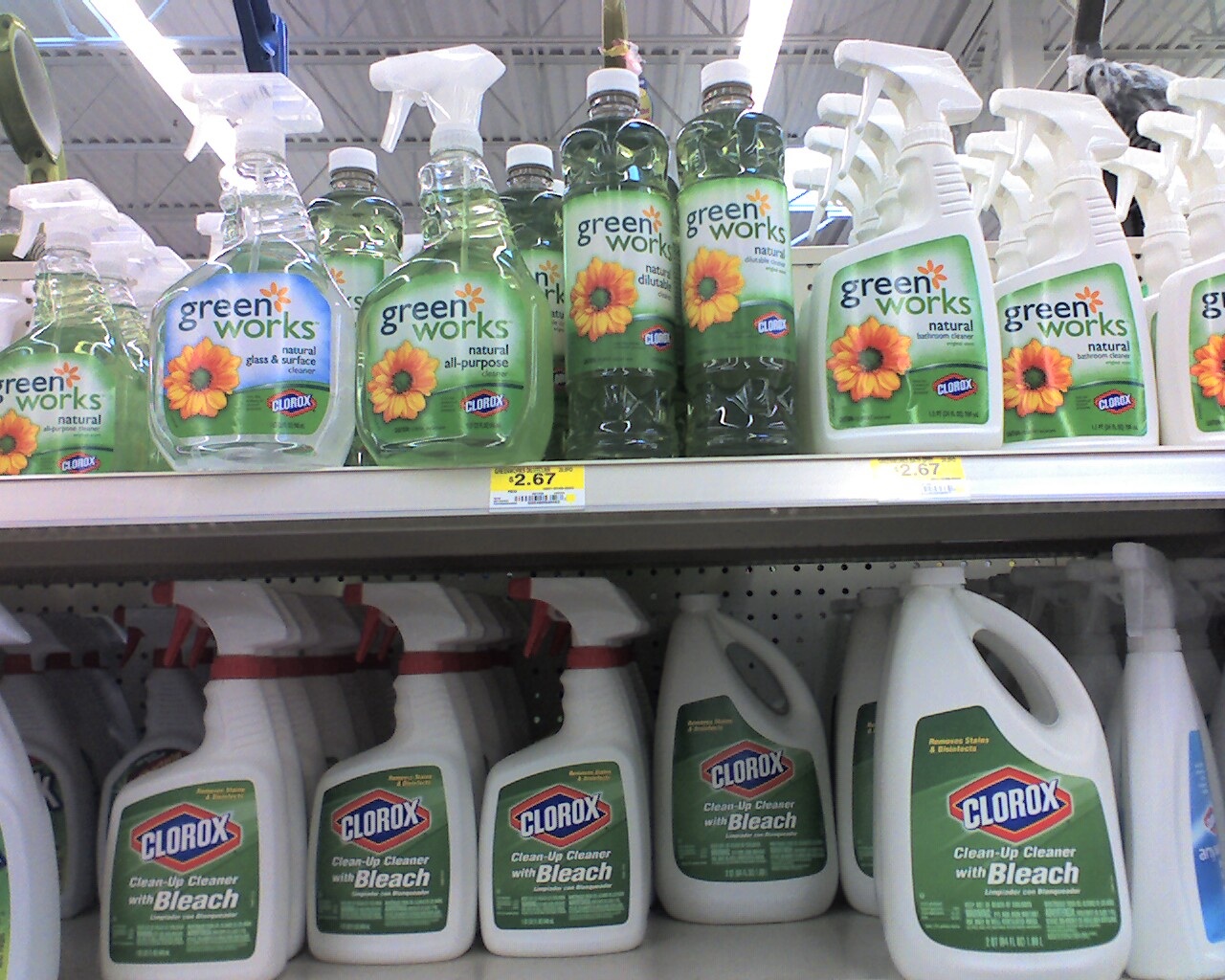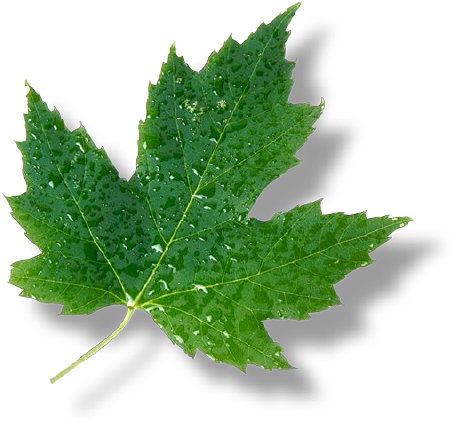Still No In-Store Refill Containers for Clorox Green Works
Back in January, OrganicMania posted a rave review about Clorox Green Works™, but questioned the lack of refill containers. How can a “green” eco-friendly product lack refill containers? At the time, a Green Works PR rep told OrganicMania that the company was “exploring this option.”
My local grocery store still isn’t carrying refill containers, so this weekend OrganicMania wandered into a Walmart, thinking that if any place would stock refill containers, it would be a superstore like Walmart, which caters to families and people making bulk purchases.
But there were none to be found. It’s now more than three months since the launch of Green Works, and still no refill containers. Do Clorox Green Works, Walmart and the other retailers just expect consumers to keep buying more and more of the small containers? Sure, they’re recyclable, but it’s not as sustainable an approach as offering refill containers.
Refill containers are important because they minimize the use of smaller, nozzled plastic containers, reduce waste, and simply because they’re something green consumers expect from a green product line. They’re a key component of source reduction, which decreases the amount of materials used during the manufacturing and distribution of products.
Funny thing is, you can easily find a 64 ounce refill container for traditional Clorox cleaners, but not for Clorox Green Works.
Can a product be truly green without a sustainable approach to packaging? Me thinks not.
4/30/08 Update: Finally, after more Internet searching, I discovered that refill containers for Green Works are available on line at multiple sources including here, here and here, as well as at warehouse clubs like Sam’s. But this approach isn’t sufficiently green for a green product. If you’re going to market as a green company, you need to be authentically green. That includes packaging considerations. More on this tomorrow, when OrganicMania talks about the Take Back the Filter campaign against Clorox and Brita water filters.
Copyright OrganicMania 2008
Filed under Green Cleaning Products, Greenwashing, Marketing, Product Recommendations, Sustainable Packaging | Wordpress Comments (6) |10 Tips for Saving Money on Organic Food: Scott Nash of MOM’s
Yesterday’s discussion about the food crisis aside, in our own homes, many of us are struggling to keep putting organic foods on the table when prices are rising with no end in sight. The New York Times recently reported that a gallon of organic milk is hitting $7 in some parts of the U.S. Yikes!
So what can you do? OrganicMania reached out for advice to Scott Nash, Founder and CEO of My Organic Market (MOM’s), an innovative organic grocer in Maryland and Virginia. Here are Scott’s top ten tips for saving money at the organic grocery store.
1. Look for a price guarantee where you shop. Some organic grocers (like MOM’s) will guarantee the lowest price.
2. Buy in bulk. There are organic grocers (like MOM’s) who will offer 10% case discounts on products like 3 lb. wheels of cheese, nuts, grains, granolas, beans, etc.
3. Substitute less expensive veggies in place of expensive ones. Think broccoli, cauliflower, green peppers, and yellow onions instead of asparagus, red peppers, and sweet onions.
4. Buy what’s in season. Organic strawberries, for example, were $6 per lb. a few weeks ago, but now they’re already down to $4 and will keep dropping.
5. For out of season produce, shop the freezer section.
6. Drink water out of the tap – it’s cheaper and better for the environment. (Editor’s Note: Studies have shown that much of the bottled water out there is not any better than what comes out of your tap, and in some cases, its of inferior quality!)
7. Choose more grains and pasta.
8. Plant a garden.
9. Try to cook fresh meals at home instead of buying prepared foods or previously frozen dishes.
10. Cook your meals on 1 or 2 days per week when you have the time and then eat them throughout the week.
Do you have other organic savings tips? Please leave a comment and share!
And stay tuned, because starting next Friday, OrganicMania kicks off a carnival of green and organic savings. We’ll be using “Mr. Linky” to gather all of your tips. Please think about planning a post for next week. You can copy it into Mr. Linky and leave a link back on your site. I’ll have more details as we get closer to launch.
Let’s all help each other out by sharing ideas!
Happy Shopping!
Lynn
Copyright OrganicMania 2008
Filed under Food, Organic Prices, Organics, Savings Tips, Where to Buy Organics | Wordpress Comments (8) |Organic vs. Conventional Foods? Count Your Blessings
I consider myself a lucky blogger. There’s so much to say about organics, going green, raising kids, and trying to make sense of healthy green living. And here at OrganicMania, we’ve had some great discussions about organics versus conventional foods, like this one and this one.
As I look through some of the nearly 300 comments (!) you’ve left on OrganicMania, I’m struck by how many of us, particularly the Mothers, are struggling to make sense of our options in order to provide what’s best for our children. This morning I was struggling a bit, too, trying to choose from a myriad of possibilities for today’s post.
But my mind kept wandering back to this story in yesterday’s Washington Post about the terrible impact of rising food prices on the world’s poor. Did you know that the UN’s World Food Program being forced to cut back on feeding programs that serve 20 million children?
Diane MacEachern, Mary Hunt, and other prominent writers and bloggers are proponents of shifting some of women’s purchasing power to green purchases. I’ve been really focused on that movement and believe it can make a huge difference.
Maybe the current crisis is an opportunity to expand our focus beyond raising green kids. It’s time to look at all the world’s children as part of the human family. When we’re so focused on organics versus conventional foods, are we at risk of thinking only of our own nuclear families? Are we losing sight of the fact that more children than ever before are starving? Did you know that one child dies every five seconds from hunger-related causes? In 2008. It’s incredible, isn’t it?
So are you struggling to make sense of organics vs. conventional foods? Count your blessings. Maybe it’s time to think about what share of money to keep for the family food budget versus donating to the starving millions.
Here’s a link to donate to the UN Food Program.
Don’t like the UN? What’s your favorite hunger charity? Leave a comment and share!
— Lynn
Copyright 2008 OrganicMania
Filed under Baby, Green Charities, Organic Prices, Organics vs. Conventional Foods, Parenting, Tips | Wordpress Comments (12) |A Travesty on Earth Day
It happened on Earth Day, in Bethesda, Maryland. In a city which has an innovative program underway to reduce the city’s carbon footprint. In a county that on that very day passed a green building law as well as laws requiring Montgomery County workers to use biofuels and to justify the use of SUVs. In a country whose President posed for a photo opp planting trees to commemorate Earth Day.
Eight healthy, beautiful, four story tall trees adjacent to a city sidewalk felled to make way for yet another condominium building. This happened on Earth Day. Really.
–Lynn
Copyright OrganicMania 2008
Filed under Green Ideas & Stuff | Wordpress Comments (5) |Serendipity: Earth Day During TV Turn-off Week
No doubt the blogosphere will be abuzz today with recommendations about how to spend your Earth Day. Clearly, if you can pick up some litter or skip a car trip, you can make a difference. But what else? How can you celebrate a meaningful Earth Day with a child?
Maybe it’s not just serendipity that causes Earth Day to fall during TV Turn-off Week. Maybe it’s Divine Inspiration.
As Treehugger pointed out, “The sad truth is that the average American kindergartener can identify several hundred logos and only a few leaves from plants and trees.”
Why not use this week, when the TV is off, to teach your kid how to recognize different trees? It’s okay if you don’t know yourself…just grab a book or an Internet print-out like this one.
The best way to develop an appreciation for the Earth and its fragile bounty is to spend time with her most magnificent creation, Nature. If a child learns to love plants, trees, and animals, he’ll naturally want to learn how to take steps to protect Nature.
So this Earth Day – TV-Turn-Off Week, get outside and appreciate what we’ve been given. Then think about what you can do to help preserve it for future generations.
Help a child learn to recognize a Maple leaf as quickly as he may recognize a McDonalds logo.
Happy Earth Day.
— Lynn
Copyright OrganicMania 2008
Filed under Easy Green Weekend Projects, Green Ideas & Stuff, Holidays, Parenting | Wordpress Comments (2) |Ten Tips for Throwing a Green Party
Hope you all had a great Earth Day weekend. I found myself at a book party for Big Green Purse author Diane MacEachern, whom I interviewed here.
Talk about pressure to be green! But it turns out I wasn’t the only one wondering how to dress. That question actually came up at the party. And according to Diane, recycled fibers are best, followed by hand-me-down or “vintage” clothing, and then organic fibers like hemp or cotton. Cotton actually takes a lot of water to grow, organic or not!
Many of the women in attendance had on very chic recycled jewelry made of buttons strung through string and other natural fibers. Apparently a lot of eco-boutiques are carrying these necklaces or – you guessed it – it’s pretty easy to make yourself.
One thing really struck me about the party. Despite the savvy of this crowd of Prius-drivers, even they complained that it’s still hard to find “green” party supplies. People were trading tips about where to find corn-based disposable, biodegradable plates and cutlery.
Here are a few tips I picked up from the Master Green Party Givers, mixed in with a couple of my own suggestions:
1. Skip the paper invitations and use an email invitation program like evite.
2. Decorate with natural materials like plants.
3. Finger food means finger food. Why use forks at all? You can serve foods like asparagus, stuffed mushrooms, cut vegetables, baked brie, cheese, mini-sandwiches, and small pastries or cookies.
4. Go organic! Of course! This includes the alcohol. You can find great organic beers on sale like this one and of course even better is biodynamic wine.
5. Re-usable cups are important. No one likes plastic (least of all your green friends). But even the biodegradable ones are still kind of plastic-y, so why not use real glass or durable re-usable plastic (if you already have them at home)?
6. Cloth napkins are always elegant, but they take on new meaning at a green party. They don’t need to be fancy. You can even use handkerchiefs or odds and ends from a variety of sets.
7. Biodegradable plates are good for the environment, and they feel sturdy, too. They’re actually much nicer to hold than regular paper plates.
8. If you must use cutlery, opt for your everyday stainless. You can wash it. It’s better than plastic that gets thrown away.
9. There’s no need for party favors. People don’t need more stuff, least of all the greenies. If you do want to give something away, a nice reusable bag is always appreciated.
10. And as Diane pointed out, you can compost the left-over party food!
–Lynn
Copyright OrganicMania 2008
Filed under Biodynamic food, Easy Green Weekend Projects, Food, Green Ideas & Stuff, Holidays, Organic Clothing, Tips | Wordpress Comments (11) |Easy Green Weekend Project #3 – Earth Day Weekend!
With Earth Day coming up on Tuesday the 22nd, there are Earth Day festivities going on all weekend long. What a perfect, easy green weekend project!
Here’s a look at fun Earth Day weekend events across the US, around the world, and in your own backyard:
The Green Apple Festival will be held in eight U.S. cities – D.C., N.Y.C., Miami, Chicago, Denver, Dallas, L.A., and San Francisco. Check out the details here at screamtobegreen.
For a look at other activities, check out this searchable list at the Earth Day Network. You can search for worldwide activities – it’s a great tool.
The Sierra Club has tons going on, as you would expect. They’ve got a terrific searchable tool, too. See it here.
And check this out: Google has a fun interactive map that allows you to put in a note about what you will be doing on Earth Day.
In your own neighborhood? How about something as simple as cleaning up a trail? Or picking litter up off a city sidewalk?
And if you’re in my neighborhood – Bethesda – check out this fun and educational event planned at Wiggle Room – all about Practical, Eco-Friendly, Non-Toxic Choices for Baby. (But you need to RSVP!)
What are you doing this weekend? Leave a comment and share!
— Lynn
Filed under Easy Green Weekend Projects | Wordpress Comments (3) |More Green Savings – “Stickers” for Kids!
There are certain things that I just HATE spending money on. Chief among them are stickers for kids. Have you ever noticed how expensive they are? Think about it- those stickers must cost just pennies to make, and they’re sold for $1.50 to $2.00 or more for a pack of 20 or so stickers. Plus, there’s the packaging issue – they’re shrink wrapped in plastic, which is environmentally harmful.
This tip came to me purely by accident. My five-year-old, a budding naturalist, admired the American Kestrel stamps at the post office. When I told him he could get ONE HUNDRED of them for just $1, he was sold. (Of course, it helps that he has to spend his allowance money on stickers!)
What’s the difference between North American Kestrel stamps and commercial stickers? Nothing except several dollars (on just one purchase) and less packaging waste!
Works for me! And I hope it works for all those Moms participating in Crunchy Chicken’s Buy Nothing Challenge – like my bloggy friends MamaBird and Gray Matters. Those women committed to buying absolutely nothing for a month – I knew I couldn’t do it this month, so I didn’t want to disappoint by signing up! Anyway, here’s hoping they have some nice stamps they can pass off to their kids as new “stickers!”
And speaking of Gray Matters, she has a great tip posted about a recycling program through the US Mail. Go check it out here!
Filed under Eco-friendly gifts, Green Ideas & Stuff, Savings Tips | Wordpress Comments (4) |Thanks to the Early BPA Pioneers
This afternoon, the US National Toxicology Program, part of the National Institutes of Health, released a draft report indicating that low dose exposure to BPA in plastics may be linked to breast cancer, prostate cancer, early puberty in girls and behavioral changes such as hyperactivity. And it’s rumored that the Canadian government will take an even stronger step on Wednesday, naming BPA a “dangerous substance.”
Many feel that this report is long overdue. The fact is, for years now, early pioneers such as the Environmental Working Group and savvy media outlets like The Wall Street Journal have been warning of the potential risks of BPA. Just last August, a group of 38 medical researchers warned again of the potential risks.
Their cry was taken up by prominent bloggers like Z Recommends, Julie Deardorff of the Chicago Tribune, and Denise and Alan Fields of Baby Bargains.
Moms have been anxiously trading stories about which bottles and sippy cups were BPA-free on blogs and parenting listservs like DCUM.
It’s just the latest example of the Precautionary Principle which Diane MacEachern explained here.
When it comes to health and environmental issues, particularly when our children are involved, you can never play it too safe.
What can you do? Go more natural. Think glass bottles and cups, find wooden toys, and get better acquainted with safer plastics, if you feel you must use plastic.
Here are some links that may be helpful to you:
Washington Post and Wall Street Journal articles
Environmental Working Group Guide to Safe Bottles and Formula
Environmental Working Group Guide to Infant Formula
Z Recommends Report on BPA (Third Edition)
Want to say “thank you” to the Environmental Working Group for these helpful guides on how to avoid BPA? Go here to have Stonyfield Farms donate $1 to the EWG when you click and fill in your email address.
Filed under Baby, Parenting | Wordpress Comments (6) |More of the Big Green Purse Interview (Part 2)
Following is Part 2 of OrganicMania’s interview with Diane MacEachern, author of the new eco-best seller Big Green Purse. Part 1 is here.
Big Green Purse aims to inspire women to use their collective purchasing power to “create a cleaner, greener world.” Did you realize that simply by buying more green products, we encourage business to produce more green products? And of course, it’s not all about buying…it’s about reducing, reusing and recycling too.
OrganicMania: In the book, you provide an overview of many of the third party seals and certifications available for green and organic products. It can really be overwhelming. People are just getting used to the USDA Organic seal, and now they’re being asked to learn about the Green Seal, the VeriFlora label, Certified Humane Raised & Handled, the SMaRT Sustainable Standard, and at least nine other seals. On top of that, they need to sort out all the bogus “natural” and “organic” claims. Do you think there is true value in having so many seals?
Diane MacEachern: I do think it’s best defined, so that it’s not brand specific, but product specific. With regard to organics, companies are forbidden by law to claim they’re organic if they’re not. But there is a loophole. For example, they can say on their label that they have used organic lime juice or organic lemons and they can get away with implying that the product is organic. There is a very strict rule about how much of the product has to actually be organic in order to use the USDA Organic seal. But companies can include organic ingredients in their products and imply that the entire product is organic. The consumer may think the product is truly organic, but if it doesn’t have that seal, it’s not organic. This is one of those things that is so annoying and that undermines organic credibility in the marketplace.
(Editor’s Note: For an example of one of these “implied organic products, read this post.)
The best organic products have the Fair Trade seal and the Organic seal. And with coffee, chances are that if you see both these seals, it’s likely shade grown as well.
OrganicMania: Let’s talk about the role of environmental contaminants and health, particularly the impact of chemical ingredients in common household products and personal care products. You write about that extensively. Do you think that the US government will ever change the way it regulates chemicals, from looking at each ingredient separately, as it does now, to looking at interactions between various chemicals? I imagine it would be very complex to do.
Diane MacEachern: None of the presidential candidates are talking about human health impacts of the environment. It’s going to be tough. I think the best thing to do for now is to choose products with the fewest number of ingredients. That gives you a greater chance that you’ll be protected.
OrganicMania: This makes me think of the Precautionary Principle you discuss at length in your book. It’s something that I think a lot of us mothers believe intuitively, but may have no idea that there is literally something called the Precautionary Principle. Can you explain the Precautionary Principle?
Diane MacEachern: The Precautionary Principle was hammered out in 1998 by a conference of scientists, researchers, and citizens. They were concerned that industry was using the lack of absolute scientific evidence as a cover to produce products suspected of having serious health and environmental consequences.
The principle is grounded in the belief that we should not wait to protect ourselves or the planet until we’re absolutely positive, from a scientific point of view, that certain products or activities – think dioxin, the burning of fossil fuels, or even cigarettes – can indeed do damage.
The principle declares, “When an activity raises threats of harm to human health or the environment, precautionary measures should be taken, even if some cause-and-effect relationships are not fully established scientifically.”
OrganicMania: Thanks so much, Diane. It’s been great hearing your thoughts and getting more insight into your terrific book. And it’s so exciting to see so many women coming together to work on issues surrounding the environment and our health.
Diane MacEachern: Yes, it is exciting. Mary Hunt, the author of “In Women We Trust,” talks about how women are grouping to save the world. Women are using blogs to carve our thoughts into the Internet wall. ‘I was here and this is what I think.’
Copyright 2008 OrganicMania
Filed under Green Ideas & Stuff, Interviews, Organic Mommypreneurs, Organics | Wordpress Comments (5) |




 My StumbleUpon Page
My StumbleUpon Page



